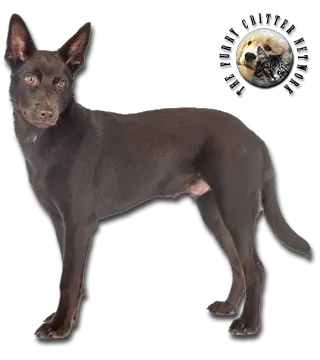Breed Standard
Head: Clean-cut, strong, and dry. Length equal to width. Moderate, well-defined stop. Black or brown nose in harmony with coat color.
Ears: Set on high. Triangular. Moderate size. Break forward or to the side when dog is alert. Prick or hanging ears are severe faults.
Eyes: Almond shape. Brown, blue, amber, or any variation or combination thereof.
Body: Strong neck. Straight, strong topline. Deep chest. Ribs well sprung. Moderately sloped croup.
Tail: Straight, naturally short or docked (may not exceed 10 cm).
Hair: Of medium length and texture. Straight and wavy. Moderate mane, frill, and culottes.
Coat: Blue merle, black, red merle. All of these colors with or without white markings, with or without tan (copper). White color must not extend beyond the withers. White permitted at the neck, on the chest, legs, and muzzle underparts, with a blaze on the head. Eyes must be fully surrounded by color.
Size: Dog: 51 to 58 cm.Bitch: 46 to 53 cm.
Weight: 20 to 25 kg.
History
The original (Working) Kelpies were working stockdogs and were formed in Australia by a number of dog breeders in the mid 1800's. By the mid 1800's, the large Australian grazing properties were being fenced and sheep numbers had grown considerably. Many of the dog breeds imported from Britain could not adapt to the work and would not stand up to the heat or terrain. There was a need for dogs that could gather, hold and move sheep from place to place. There were a number of people in Australia who strived to have the best sheepdogs. These people selectively bred working dogs by mixing different strains of working Colleys in Britain and Ireland, and developing them to suit the needs of Australian conditions and Australian methods of handling sheep and stock to form what was called the Working Kelpie. The Dingo also played a part in some of the early development. It is thought by some that the Kelpie has an "influence of the merle breed in their foundations" this has not been found in the history of the Kelpie. It is estimated that today there are more than 450,000 sheepdogs working in Australia, the vast majority are Working Kelpies. Most people are under the impression that a Kelpie was formed from the Border Collie, this is not true. Border Collies were not established in Australia until after 1901.
Behavior
The Kelpie is not an aggressive dog by nature. They would rather spend their time working livestock, than scuffling with another dog. If socialized properly, they interact very well with children.
Kelpies fall into three categories. The first are the ones that love everyone and everything. They are very outgoing and can be somewhat of a handful. They greet everyone with unbridled enthusiasm. These Kelpies tend to be on the excitable and hyper side. They usually do not do well in an apartment type setting. If they are housed next to another dog, they spend all their time mimicking the movements of the other dog. If there isn't another dog close, they will mimick the movements of anything outside their fenced area (bikers, cars, joggers, etc...).
The second category is the most common. These Kelpies are even tempered and nothing seems to bother them. This type of temperament does well in a working (herding livestock) home. They can adapt and work in any situation. Outside distractions and noises do not bother them, because they are focused on their job at hand. These dogs are friendly to everyone and are non-reactive. They tend to be devoted to their owner and immediate family (and close friends) but usually don't come running over when called by someone else.
The third temperament are the ones that are a bit aloof (reserved) of strangers. These Kelpies are the minority. They are very faithful and loyal to their owners but don't like strangers much. They are not aggressive. They just move away and get on with their work. These dogs can sometimes make great companion dogs.
Kelpies do not make good guard dogs and very seldom are aggressive enough to bite strangers.
This dog of almost unlimited energy is made for wide-open spaces. He should not be kept in enclosed spaces and is not made for life indoors. Regular brushing is sufficient to maintain the coat.
Function
Herder, Pet.
Health
Kelpies are a hardy breed with few health problems, but they are susceptible to disorders common to all breeds, such as cryptorchidism, hip dysplasia, cerebellar abiotrophy and luxating patella.
Some lines contain PRA (Progressive Retinal Atrophy), which is retinal degeneration causing partial to total blindness.






